Vijay Aski
Knowledge Distillation Using Frontier Open-source LLMs: Generalizability and the Role of Synthetic Data
Oct 24, 2024



Abstract:Leading open-source large language models (LLMs) such as Llama-3.1-Instruct-405B are extremely capable at generating text, answering questions, and solving a variety of natural language understanding tasks. However, they incur higher inference cost and latency compared to smaller LLMs. Knowledge distillation provides a way to use outputs from these large, capable teacher models to train smaller student models which can be used for inference at lower cost and latency, while retaining comparable accuracy. We investigate the efficacy of distillation using the Llama-3.1-405B-Instruct teacher and the smaller Llama-3.1-8B-Instruct and Llama-3.1-70B-Instruct student models. Contributions of this work include (a) We evaluate the generalizability of distillation with the above Llama-3.1 teacher-student pairs across different tasks and datasets (b) We show that using synthetic data during distillation significantly improves the accuracy of 8B and 70B models, and when used with reasoning chains, even matches or surpasses the zero-shot accuracy of 405B model on some datasets (c) We empirically show that distillation enables 8B and 70B models to internalize 405B's reasoning ability by using only standard fine-tuning (without customizing any loss function). This allows cost and latency-efficient student model inference. (d) We show pitfalls in evaluation of distillation, and present task-specific evaluation, including both human and LLM-grading, and ground-truth based traditional accuracy benchmarks. This methodical study brings out the fundamental importance of synthetic data quality in knowledge distillation, and of combining multiple, task-specific ways of accuracy and quality evaluation in assessing the effectiveness of distillation.
MedImageInsight: An Open-Source Embedding Model for General Domain Medical Imaging
Oct 09, 2024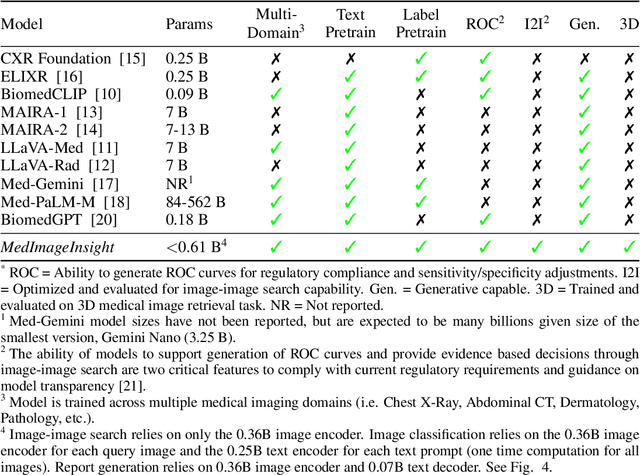
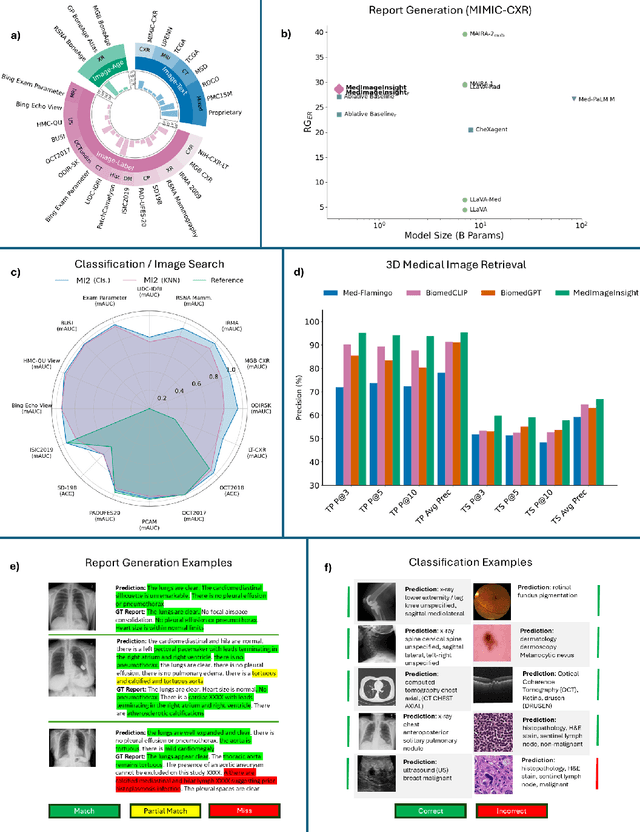
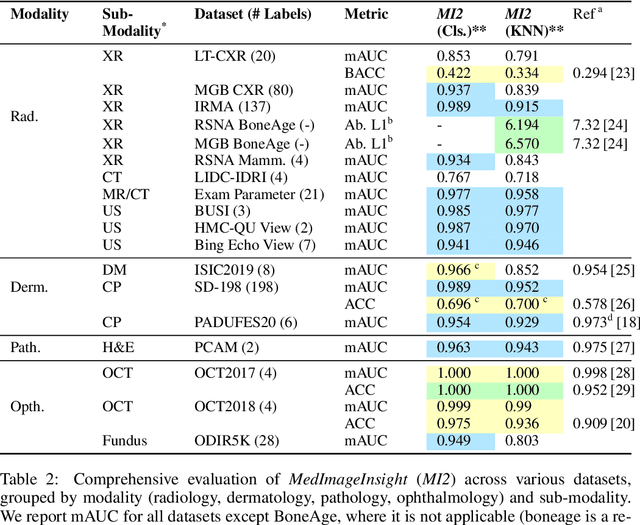
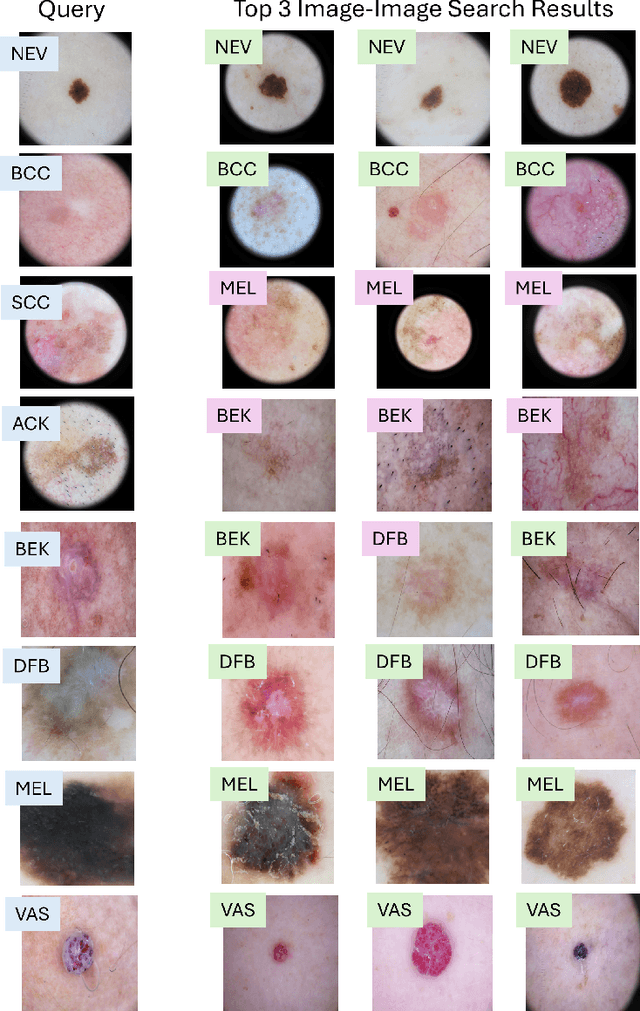
Abstract:In this work, we present MedImageInsight, an open-source medical imaging embedding model. MedImageInsight is trained on medical images with associated text and labels across a diverse collection of domains, including X-Ray, CT, MRI, dermoscopy, OCT, fundus photography, ultrasound, histopathology, and mammography. Rigorous evaluations demonstrate MedImageInsight's ability to achieve state-of-the-art (SOTA) or human expert level performance across classification, image-image search, and fine-tuning tasks. Specifically, on public datasets, MedImageInsight achieves SOTA in CT 3D medical image retrieval, as well as SOTA in disease classification and search for chest X-ray, dermatology, and OCT imaging. Furthermore, MedImageInsight achieves human expert performance in bone age estimation (on both public and partner data), as well as AUC above 0.9 in most other domains. When paired with a text decoder, MedImageInsight achieves near SOTA level single image report findings generation with less than 10\% the parameters of other models. Compared to fine-tuning GPT-4o with only MIMIC-CXR data for the same task, MedImageInsight outperforms in clinical metrics, but underperforms on lexical metrics where GPT-4o sets a new SOTA. Importantly for regulatory purposes, MedImageInsight can generate ROC curves, adjust sensitivity and specificity based on clinical need, and provide evidence-based decision support through image-image search (which can also enable retrieval augmented generation). In an independent clinical evaluation of image-image search in chest X-ray, MedImageInsight outperformed every other publicly available foundation model evaluated by large margins (over 6 points AUC), and significantly outperformed other models in terms of AI fairness (across age and gender). We hope releasing MedImageInsight will help enhance collective progress in medical imaging AI research and development.
A Study of Optimizations for Fine-tuning Large Language Models
Jun 04, 2024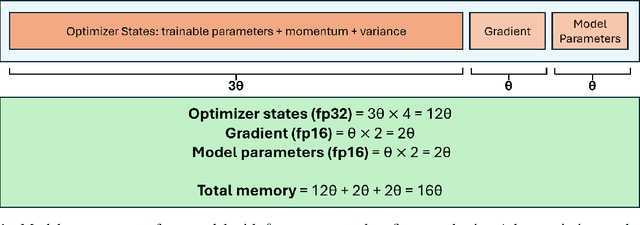

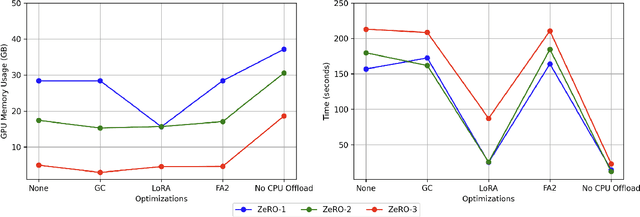

Abstract:Fine-tuning large language models is a popular choice among users trying to adapt them for specific applications. However, fine-tuning these models is a demanding task because the user has to examine several factors, such as resource budget, runtime, model size and context length among others. A specific challenge is that fine-tuning is memory intensive, imposing constraints on the required hardware memory and context length of training data that can be handled. In this work, we share a detailed study on a variety of fine-tuning optimizations across different fine-tuning scenarios. In particular, we assess Gradient Checkpointing, Low Rank Adaptation, DeepSpeed's ZeRO Redundancy Optimizer and Flash Attention. With a focus on memory and runtime, we examine the impact of different optimization combinations on GPU memory usage and execution runtime during fine-tuning phase. We provide recommendation on best default optimization for balancing memory and runtime across diverse model sizes. We share effective strategies for fine-tuning very large models with tens or hundreds of billions of parameters and enabling large context lengths during fine-tuning. Furthermore, we propose the appropriate optimization mixtures for fine-tuning under GPU resource limitations.
Injecting New Knowledge into Large Language Models via Supervised Fine-Tuning
Apr 02, 2024Abstract:In recent years, Large Language Models (LLMs) have shown remarkable performance in generating human-like text, proving to be a valuable asset across various applications. However, adapting these models to incorporate new, out-of-domain knowledge remains a challenge, particularly for facts and events that occur after the model's knowledge cutoff date. This paper investigates the effectiveness of Supervised Fine-Tuning (SFT) as a method for knowledge injection in LLMs, specifically focusing on the domain of recent sporting events. We compare different dataset generation strategies -- token-based and fact-based scaling -- to create training data that helps the model learn new information. Our experiments on GPT-4 demonstrate that while token-based scaling can lead to improvements in Q&A accuracy, it may not provide uniform coverage of new knowledge. Fact-based scaling, on the other hand, offers a more systematic approach to ensure even coverage across all facts. We present a novel dataset generation process that leads to more effective knowledge ingestion through SFT, and our results show considerable performance improvements in Q&A tasks related to out-of-domain knowledge. This study contributes to the understanding of domain adaptation for LLMs and highlights the potential of SFT in enhancing the factuality of LLM responses in specific knowledge domains.
RAG vs Fine-tuning: Pipelines, Tradeoffs, and a Case Study on Agriculture
Jan 30, 2024Abstract:There are two common ways in which developers are incorporating proprietary and domain-specific data when building applications of Large Language Models (LLMs): Retrieval-Augmented Generation (RAG) and Fine-Tuning. RAG augments the prompt with the external data, while fine-Tuning incorporates the additional knowledge into the model itself. However, the pros and cons of both approaches are not well understood. In this paper, we propose a pipeline for fine-tuning and RAG, and present the tradeoffs of both for multiple popular LLMs, including Llama2-13B, GPT-3.5, and GPT-4. Our pipeline consists of multiple stages, including extracting information from PDFs, generating questions and answers, using them for fine-tuning, and leveraging GPT-4 for evaluating the results. We propose metrics to assess the performance of different stages of the RAG and fine-Tuning pipeline. We conduct an in-depth study on an agricultural dataset. Agriculture as an industry has not seen much penetration of AI, and we study a potentially disruptive application - what if we could provide location-specific insights to a farmer? Our results show the effectiveness of our dataset generation pipeline in capturing geographic-specific knowledge, and the quantitative and qualitative benefits of RAG and fine-tuning. We see an accuracy increase of over 6 p.p. when fine-tuning the model and this is cumulative with RAG, which increases accuracy by 5 p.p. further. In one particular experiment, we also demonstrate that the fine-tuned model leverages information from across geographies to answer specific questions, increasing answer similarity from 47% to 72%. Overall, the results point to how systems built using LLMs can be adapted to respond and incorporate knowledge across a dimension that is critical for a specific industry, paving the way for further applications of LLMs in other industrial domains.
GPT-4 as an Agronomist Assistant? Answering Agriculture Exams Using Large Language Models
Oct 12, 2023Abstract:Large language models (LLMs) have demonstrated remarkable capabilities in natural language understanding across various domains, including healthcare and finance. For some tasks, LLMs achieve similar or better performance than trained human beings, therefore it is reasonable to employ human exams (e.g., certification tests) to assess the performance of LLMs. We present a comprehensive evaluation of popular LLMs, such as Llama 2 and GPT, on their ability to answer agriculture-related questions. In our evaluation, we also employ RAG (Retrieval-Augmented Generation) and ER (Ensemble Refinement) techniques, which combine information retrieval, generation capabilities, and prompting strategies to improve the LLMs' performance. To demonstrate the capabilities of LLMs, we selected agriculture exams and benchmark datasets from three of the largest agriculture producer countries: Brazil, India, and the USA. Our analysis highlights GPT-4's ability to achieve a passing score on exams to earn credits for renewing agronomist certifications, answering 93% of the questions correctly and outperforming earlier general-purpose models, which achieved 88% accuracy. On one of our experiments, GPT-4 obtained the highest performance when compared to human subjects. This performance suggests that GPT-4 could potentially pass on major graduate education admission tests or even earn credits for renewing agronomy certificates. We also explore the models' capacity to address general agriculture-related questions and generate crop management guidelines for Brazilian and Indian farmers, utilizing robust datasets from the Brazilian Agency of Agriculture (Embrapa) and graduate program exams from India. The results suggest that GPT-4, ER, and RAG can contribute meaningfully to agricultural education, assessment, and crop management practice, offering valuable insights to farmers and agricultural professionals.
 Add to Chrome
Add to Chrome Add to Firefox
Add to Firefox Add to Edge
Add to Edge